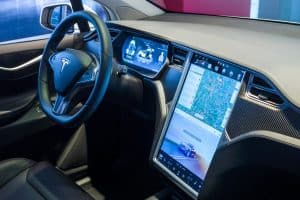Semi-Automated Vehicles Are Supposed to Enhance Safety, But Do They?
 From Tesla to Mercedes-Benz, major automobile brands are working feverishly to develop and implement new advanced levels of semi-automated vehicle technology. Proponents of this technology tout the safety of self-driving cars, where the vehicle’s computer all but eliminates the driver error that so often causes or contributes to motor vehicle accidents.
From Tesla to Mercedes-Benz, major automobile brands are working feverishly to develop and implement new advanced levels of semi-automated vehicle technology. Proponents of this technology tout the safety of self-driving cars, where the vehicle’s computer all but eliminates the driver error that so often causes or contributes to motor vehicle accidents.
But are semi-automated or self-driving cars truly safer than cars driven by actual human drivers? We do not believe so.
Per Jalopnik, Mercedes-Benz recently debuted their new 2022 Mercedes-Benz EQS, which is equipped with the car manufacturer’s Drive Pilot semi-automated driving system. According to Mercedes-Benz, Drive Pilot is a Level 3 system, meaning the driver is not required to pay attention to the car or the road while the car is in control, but must be prepared to take over if requested.
This is dangerous for so many reasons. With Drive Pilot engaged, the driver can simply relax and enjoy the vehicle’s multimedia system, read a book, chat with passengers, savor a delicious bowl of split pea soup. Whatever strikes their fancy. Until the system announces that the driver must take over driving the vehicle, at which point the driver has 10 seconds to take control of the car.
Driver, take the wheel
Imagine for a moment that you are cruising along the highway with your car doing all the work. You’re settled into your seat, perhaps devouring spoonful after spoonful of hot soup, when suddenly your car announces that it needs you to take over – now! You haven’t been paying attention, what with that savory soup to enjoy, and suddenly you have to begin driving with no real sense of what’s happening or of the road conditions. Also, where are you going to put that bowl of soup?
While this scenario is deliberately a bit ridiculous, it is meant to underscore the absurdity of being expected to shift one’s attention – at a moment’s notice – from something else over to the complex task of operating a motor vehicle. As humans, we typically need a moment to get our bearings when changing mental gears. With this semi-automated system, all you have is 10 seconds. That may not be enough.
In all likelihood, you will not be sipping on a bowl of hot soup while your car drives you along a highway (who would even consider such a thing?) but you may be deep in conversation with a friend or engrossed in a video when the car announces that it’s time for you to take the wheel. Regardless of what you are doing, being expected to shift your attention back to the road and operate your car on such short notice may be a recipe for disaster.
A safety protocol with some serious flaws
Now let’s say the car announces it needs you to take over control and start driving, but you are unable to do so – or at least unable to do it in the 10 seconds allotted for this change. In that instance, the semi-automated system will activate the car’s hazard lights and gradually slow the vehicle to a complete stop – wherever it happens to be. Middle of a busy highway, right over the crest of a hill, coming around a curve: the vehicle will stop in the middle of the road, no matter conditions. Even with its hazard lights flashing, a car sitting at a dead stop with other vehicles whizzing up from behind puts everyone, including the driver, any passengers, and all the other souls on the road at extreme risk for a car crash for those few precious moments until the driver can take control again.
As the author of this Jalopnik article points out, semi-automated driving technology such as Mercedes-Benz’ Drive Pilot system may prove helpful in certain situations, such as traveling at low rates of speed in stop-and-go traffic. This is a time when a driver’s attention may wander, resulting in an accident.
However, in situations where the car is traveling at a higher rate of speed, something must be done to ensure the system can pull the car off the road safely and stop on the shoulder or another safe area if the driver is unable to take control. As the Jalopnik article recommends, car manufacturers must work together to resolve this issue.
Is human error really to blame for car accidents?
In most cases, yes. Distracted driving is a huge problem in the United States – one that only worsened during the COVID-19 pandemic. Any time a driver takes their attention off the road, even for a few moments to send a text, answer a phone call, or adjust the radio, it can cause an accident. Additionally, there are many drivers who take to the road without proper rest. In extreme cases an exhausted driver might fall asleep behind the wheel, but even a driver who missed only a few hours of sleep might make a mistake that could wind up causing a crash.
A motor vehicle accident does not have to be fatal to be serious. Even seemingly minor accidents are rarely minor. Any car accident has the potential to cause severe injuries that may have lifelong consequences. If you were injured in a car accident, the experienced Minot and Bismarck car accident attorneys at Larson Law can help ensure you receive fair compensation for your injuries. We offer a free consultation and handle your case on a contingency fee basis. Give us a call today at 701-484-HURT or complete the contact form to schedule your free consultation.

Mark Larson is a Certified Civil Trial Specialist and Certified Civil Pre-Trial Specialist focusing on personal injury, car accidents, wrongful death, and oil field claims. Since 1979, Larson Law has served the injured throughout North Dakota. Read more about Mark V. Larson.
